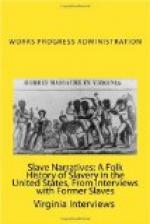I was about 11 years old when peace came and was living with my mother and the other children on the Badgett plantation about 7 miles east of Little Rock. Mother did laundry and general house work. Being a small child, all that was asked of me was to run errands and amuse the little white children. Madam, if I could tell you the great difference between slave owners it would help you in understanding conditions of today among the colored people. Both my father and my mother had peculiar privileges. The Ashley family were exceptional slave owners; they permitted their servants to hire their time. There was class distinction, perhaps to greater extent than among the white people. Yes, madam, the slaves who lived in the family with master and mistress were taught just about the same as their own children. At any rate, they imitated them in all matters; to speak with a low voice, use good English, the niceties of manners, good form and courtesy in receiving and attending guests.
I began teaching in Little Rock schools when I was 15 years old and am still teaching. In all, it is 69 years, and my contract is still good. My first experience as a teacher, (as I told you I was fifteen) was by substituting for a teacher in that first Missionary school, in 1869. For some reason, she did not return, and the School Board appointed me in her place. After one year I was given leave of absence to attend Oberlin College in Ohio. I spent three years there, but not in succession. When my money would give out I would come home and the School Board would provide work for me until I could earn enough to carry me through another term. I finished at Oberlin in 1873. I extended my work through courses at Normal schools and Teacher’s Institutes. I have taken lecture courses in many colleges, notably the University of California in 1922. I have taught all grades from the first to the twelfth. My principal work, for the last 35 years, however, has been high school Latin and English and Science.
At present I am serving as librarian at the Senior high school and Junior College. I have twice served as principal of city schools in Little Rock. First at Capitol Hill. The Charlotte E. Stephens school at 18th and Maple was named in my honor. I have a book I have kept for 68 years regarding those first schools, and I’m told it is the only one in existence. I also have the first monthly report card ever issued in Little Rock. Mr. Hall (Superintendent of Little Rock City Schools) has asked me to will it to the School Board.
I could recall many interesting events of those early schools for the colored race. Old, old slaves came, desiring to learn to read and spell. They brought the only books they could find, many of which proved to be almanacs, paper bound novels discarded by their mistress and ancient dictionaries, about half of which might be missing.




